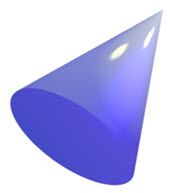Bands usually play on a stage and are separated but space between each other so bands always play in a 3-d space.
A band, even in a studio, never plays from the exact same place simultaneously.
In other words, music is
always played in a 3-D space so the simplest atmos mix would literally be just to capture each band members position on the stage or studio. This is mostly (the majority) on a 2-D plane but the atmos 3-D would fill in the "atmosphere". When a band plays on stage the amp don't send out sound waves in a direct x,y line, the waves are like "cones" that have an x,y, z-axis
Atmos would simply recreate this "cone" sound wave for each instrument, band member, etc
"stereo" captures a flat "slice" or flat "plane" thru the cone, atmos captures the whole top and bottom of that flat slice





